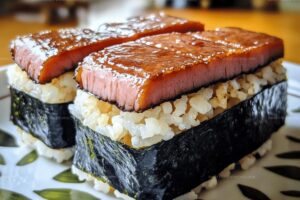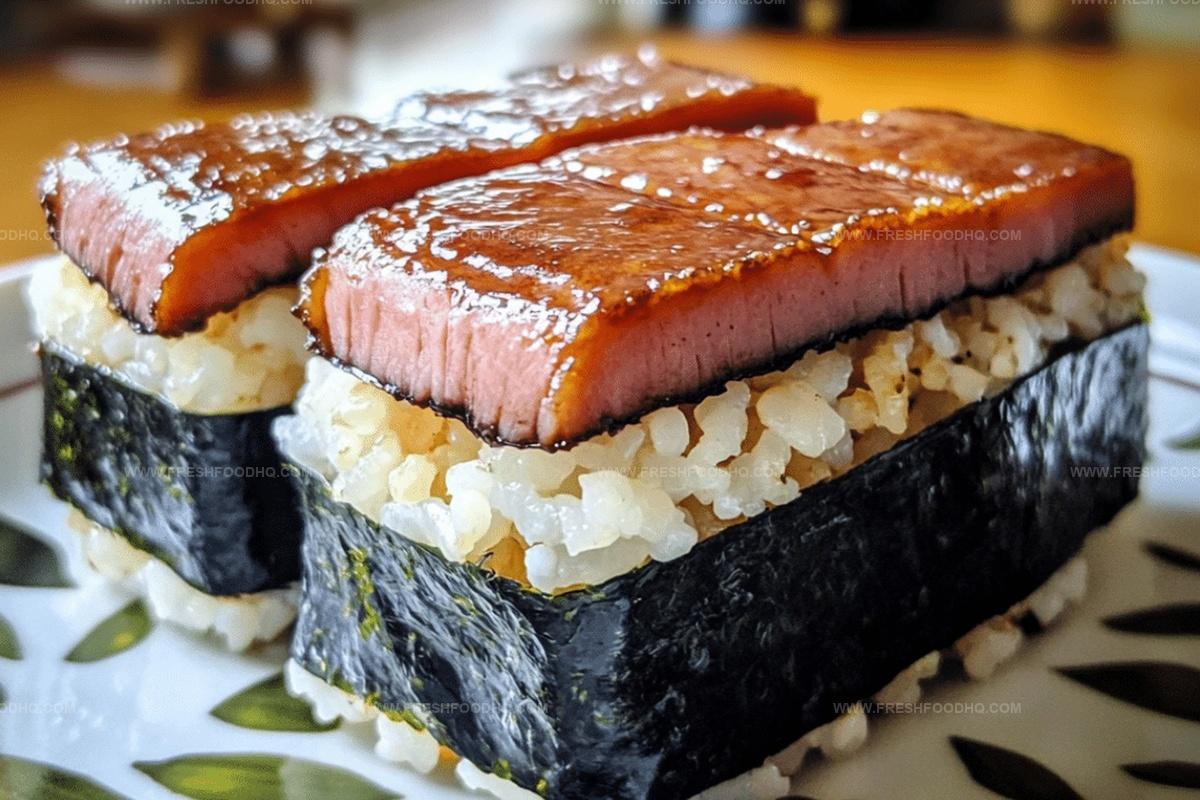Easy Homemade Spam Musubi Recipe: Hawaiian Sushi Nori Delight
Crafting a delectable hawaiian spam musubi becomes an adventure in your kitchen, blending island flavors with simple ingredients.
Salty, crispy spam transforms into a delightful handheld treat that captures Pacific culinary magic.
Japanese-inspired techniques merge with traditional Hawaiian street food for an irresistible snack.
Layers of seasoned rice and perfectly grilled meat create a compact, mouthwatering experience.
Nori seaweed wraps everything into a neat, portable package that sparks instant comfort.
Minimal effort delivers maximum flavor, making this recipe a go-to for quick meals.
You’ll find yourself falling in love with this quick, satisfying cultural fusion that promises to become a personal favorite.
Tasty Variations For Easy Hawaiian Spam Musubi
What Goes With Easy Hawaiian Spam Musubi
How To Store Easy Hawaiian Spam Musubi
Easy Hawaiian Spam Musubi FAQs
A traditional Hawaiian snack that combines grilled Spam, sushi rice, and nori seaweed, created by Japanese immigrants in Hawaii as a portable, delicious meal.
While tasty, it’s high in sodium and calories. Enjoy in moderation as an occasional treat, and consider using lower-sodium Spam or adding vegetables.
No, you just need a pan for frying Spam, a rice cooker or pot for rice, and a flat surface to assemble. A musubi mold helps but isn’t required.
Try replacing Spam with marinated tofu, grilled eggplant, or plant-based meat alternatives to create a similar texture and flavor profile.
Why You’ll Love Easy Hawaiian Spam Musubi
What You’ll Need For Easy Hawaiian Spam Musubi
Main Ingredients:Seasoning and Flavor Enhancers:Optional Garnish:How To Make Easy Hawaiian Spam Musubi
Step 1: Prepare Perfect Sushi Rice
Cook sushi rice following package guidelines. Allow the rice to cool down completely at room temperature, fluffing it gently with a rice paddle to prevent clumping.
Step 2: Sizzle Savory Spam Slices
Cut Spam into uniform slices. Heat a skillet over medium-high heat and cook Spam until edges are crispy and golden brown, creating a delicious caramelized exterior.
Step 3: Create Flavorful Glaze
In a small saucepan, combine:Simmer the mixture until sugar dissolves completely, creating a sweet and tangy sauce for your Spam.
Step 4: Assemble Musubi Base
Place a sheet of nori seaweed on a clean surface. Lay a cooked Spam slice in the center. Add a generous scoop of cooled rice on top of the Spam. Sprinkle furikake seasoning for extra flavor if desired.
Step 5: Roll and Seal Musubi
Carefully wrap the nori around the Spam and rice, using a small amount of water to seal the seaweed edge. Press gently to ensure a tight, compact roll.
Step 6: Slice and Serve
Using a sharp knife, cut the musubi into bite-sized pieces. Arrange on a serving plate and enjoy your homemade Hawaiian Spam Musubi immediately for the best taste and texture.
Helpful Notes For Easy Hawaiian Spam Musubi
Print
Easy Hawaiian Spam Musubi with Sushi Nori Seaweed Recipe
- Total Time: 25 minutes
- Yield: 5 1x
Description
Savor Hawaii’s street food favorite, Hawaiian Spam Musubi, a portable feast blending salty grilled spam with seasoned sushi rice and crisp nori. Sushi rice, caramelized spam, and seaweed wrap create a quick, delicious snack you’ll crave again and again.
Ingredients
Main Protein:
- 1 can spam
Rice and Wrapper:
- 2 cups sushi rice
- 5 sheets sushi nori seaweed
Sauce and Seasoning:
- 1/2 cup soy sauce
- 1/4 cup sugar
- 1/4 cup rice vinegar
- Furikake seasoning (optional)
Instructions
- Prepare sushi rice according to package guidelines, allowing it to cool to room temperature for optimal texture and handling.
- Cut Spam into uniform slices, then sizzle in a hot skillet until edges turn golden and crispy, approximately 2-3 minutes per side.
- Create a glaze by whisking soy sauce, sugar, and rice vinegar in a small pot, simmering until the sugar completely dissolves and the mixture thickens slightly.
- Position a sheet of nori seaweed on a clean cutting board, ensuring smooth side faces downward.
- Arrange a perfectly browned Spam slice in the center of the nori, then carefully spread a layer of cooled rice directly on top.
- Sprinkle furikake seasoning across the rice for an extra burst of umami flavor, if desired.
- Carefully fold the nori around the Spam and rice, using a small amount of water to seal the edges and create a tight roll.
- Slice the musubi into bite-sized portions using a sharp knife, wiping the blade between cuts for clean edges.
- Serve immediately while the Spam remains warm and the nori stays crisp, optionally accompanied by additional soy sauce for dipping.
Notes
- Opt for short-grain sushi rice to achieve the perfect sticky texture that helps bind the musubi together.
- Pan-fry Spam at medium-high heat to create a caramelized exterior while keeping the inside tender and juicy.
- Create a quick glaze by reducing soy sauce, sugar, and rice vinegar to add depth of flavor and enhance the Spam’s richness.
- For a gluten-free version, swap traditional soy sauce with tamari and ensure all ingredients are certified gluten-free.
- Prep Time: 10 minutes
- Cook Time: 15 minutes
- Category: Lunch, Snacks
- Method: Frying
- Cuisine: Hawaiian
Nutrition
- Serving Size: 5
- Calories: 335 kcal
- Sugar: 8 g
- Sodium: 940 mg
- Fat: 14 g
- Saturated Fat: 5 g
- Unsaturated Fat: 7 g
- Trans Fat: 0.2 g
- Carbohydrates: 38 g
- Fiber: 1 g
- Protein: 9 g
- Cholesterol: 40 mg


Samantha Lee
Recipe Developer & Content Creator
Expertise
Plant-based and vegetarian recipes, Recipe testing and development, Food blogging and digital content creation, Culinary education and workshops
Education
Oregon Culinary Institute (Portland, OR)
Samantha sees cooking like painting, every fresh herb, every juicy tomato, a new splash of color on a canvas.
After graduating from Oregon Culinary Institute, she blended her love of global cuisines and plant-based cooking into recipes that feel fresh, fearless, and full of heart.
Samantha’s kitchen is a place where comfort food gets a modern remix and every meal feels like a little adventure. When she’s not cooking, she’s out exploring farmers’ markets, sketching new recipe ideas, or getting her hands dirty in a community garden.